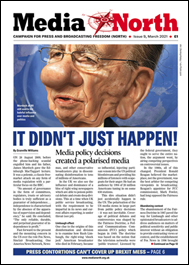
About
MediaNorth
MediaNorth is the quarterly publication of the Campaign for Press & Broadcasting Freedom (North) which covers the North West, Yorks & Humber and North East of England. We also have supporters in Scotland.
CPBF (North) highlights threats to regional media such as the assaults on jobs and conditions in local and regional newspapers, and campaigns for strong regional media. We also strongly support alternative media, both print and online.
Nationally we want diverse, democratically accountable media.
CPBF (North) publishes books and pamphlets, and holds public meetings. If you want to support CPBF(North) you can do three things:
– Contact us at cpbfnorth@outlook.com to join our email list to receive future issues of MediaNorth, details of public meetings and other news
– Become a friend of CPBF(North) on Facebook at Campaign for Press and Broadcasting Freedom North
– Make a donation
or take out a standing order to support our work. Contact us at cpbfnorth@outlook.com
and we’ll give you the details on how to pay.

|

We can't fight fake news without
saving local journalism
By Emily Bell
ONE of the very few heroes of the UK election campaign is James Mitchinson, editor of the Yorkshire Post. Mitchinson’s email to a reader who would not believe a (true) story about a sick child left to wait on the floor of a Leeds hospital is a model of both public service journalism and how to debunk a lie. “Whatever you do, do not believe a stranger on social media who disappears into the night.” The email is an open letter to all readers now and you can read it on the Yorkshire Post’s website.
If you do visit the page on the Yorkshire Post, you will find Mitchinson’s measured words about how his journalists check stories and how the fabric of the lie spread initially on Facebook came apart under scrutiny. If you scroll further you will also come to components of the page which contain both other legitimate stories from the Post and headlines from an automated advertising service called Taboola. The Taboola headlines are not giving readers useful information, but rather startling prompts such as: Angelina Jolie’s Daughter Used to Be Adorable, But Now She Looks Insane. Scroll further and you will come to the reader comments on the piece which are hosted by Facebook itself. Within the comments there are dozens of readers who talk straight past Mitchinson’s reason with their own conspiracy theories. “I don’t know who is telling the truth here,” starts the very first comment on the thread. “But I do know if my child was so ill, taking a picture of it and sending it to a newspaper would be the last thing on my mind.”
The page on the Yorkshire Post’s website is a stunning example of why there is currently a crisis of credibility in news and information. For a dwindling number of journalists to be paid to dispel the social media “dust cloud of nonsense”, as Barack Obama once called it, their publications have to rely on the services of companies such as Facebook and Taboola, who make money from having disgracefully low or non-existent editorial standards themselves. Careful lessons on how to parse disinformation are themselves sitting on a dung heap of dubious advertising and problematic content which is – unlike the journalism – highly profitable for third-party companies.
If you look further, you can read about what this asymmetry in the commercial market for information has done to local news in general. The Yorkshire Post’s owner, JPIMedia, is the ghost of Johnston Press, the 252-year-old company that went into administration in 2018. The Yorkshire Post and its local newspaper stablemates are in the process of being sold. This is a worldwide trend: the shrinkage of local newsrooms as the result of advertising revenues flowing instead to advertising companies such as Facebook and Google.
After the shock result of the 2016 US presidential election, journalists and researchers spent time peeling back the lid on a can of disinformation worms. One social media researcher, Leon Yin, who at the time was working at New York University studying the effects of social media and politics, noticed that a Russian troll farm, the Internet Research Agency, had shared lots of links through its networks during the 2016 election. But only a very few, Yin says, were links to fake news sites. “What I noticed was a majority of the stories being shared were local,” Yin told a conference on disinformation and elections at Columbia University in New York last week. Local news is a vulnerability. In the 2020 election cycle, we are already seeing a rise in hundreds of phantom “local news sites” set up by political operatives to churn out automated stories that fit particular talking points. The resources at a local level to counter these operations are shrinking. Two of America’s largest news chains, Gannett and GateHouse Media are merging with the declared intention of cutting half a billion dollars from their bottom line. McClatchy, another titan of local news, is battling to stay afloat.
The Washington Post columnist Margaret Sullivan notes that in the index of trusted news sources, local reporting can often rank higher than national news. Preserving these local outlets may be our best hope of repairing some consensus around facts. “They still are one of the ways that many communities maintain a sense of unity and shared facts,” Sullivan says. “Losing that should be unthinkable. But as of this moment, it isn’t.”
Since the 2016 election in the US revealed how easy it is to manipulate social media platforms, there have been dozens if not hundreds of initiatives to “fight disinformation” as it represents a “crisis for democracy”. Last week alone, I attended one conference on disinformation and the press, organised another, and failed to attend a further three. The incredibly gloomy consensus among everyone I listened to or spoke with was that not enough progress has been made in the past three years to effectively deal with the consequences of a polluted news and information environment. Journalists themselves have not been quick enough to understand the levers of disinformation and how they both amplify or recirculate material which is false or intentionally distracting.
American academic Whitney Phillips, who studies disinformation, describes our current approach to the problem as being akin to an environmental movement which tries to clean up a few yards of beach rather than tackle the systemic problem of pollution. The tech platforms have enthusiastically advanced the binary fixes of fact checking, and more moderation, which, in Phillips’s adept analogy is very much like cleaning a stretch of beach whilst a broken oil pipe spews into the ocean.
At the end of a UK election where the ruling party changed its own social media account to “fact check uk” specifically to mislead readers, where a study by First Draft of nearly 7,000 Conservative ads on Facebook found 88% of them were “misleading”, and where stories like the boy on the hospital floor continued to be debated despite clear confirmation, it seems that we are further away than ever from establishing a shared interest in valuing the truth.
This is not an accident. Although it would be tempting to put the Conservative party’s economy with the facts down to accident or incompetence, it is part of a deliberate and consistent strategy to keep populations in a perpetual state of doubt about what truth is. Invert the truth, discredit the press. This has traditionally been the playbook of dictators, but it is also adopted by politicians in democracies as an effective tactic to advance their own agendas. The lack of adequate regulations or advertising policies to curb the slipperiness is astonishing, yet for politicians to either boost investment into public service journalism or to introduce more stringent advertising regulations would be like the proverbial turkeys passing the Christmas Dinner Bill.
Writing in the Observer this weekend, Alan Rusbridger argues that we need more good journalism as a key defence against the rising tide of noxious content – and who could disagree? But we also need regulation and legislation – and we need a totally reformed business model for platforms and tech companies. We need journalists and media organisations to realise that they too are too often part of the problem. And we need money, lots of it, taken from one set of people – advertising companies and advertisers themselves – and redirected into real public infrastructure, be it schools, news organisations or even public spaces, to rebuild what we need from the ground up.
This artcle first appeared at www.theguardian.com
CLICK HERE TO RETURN TO READINGS PAGE |